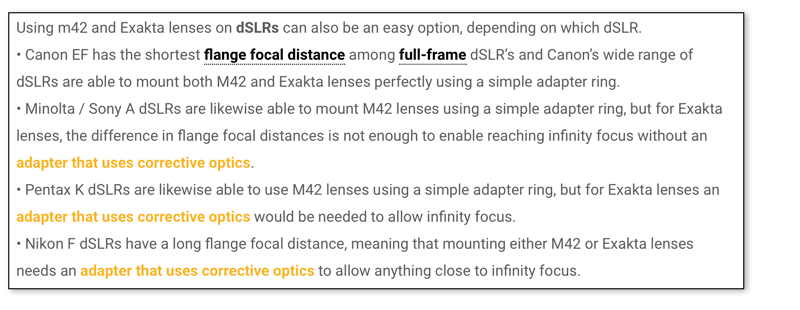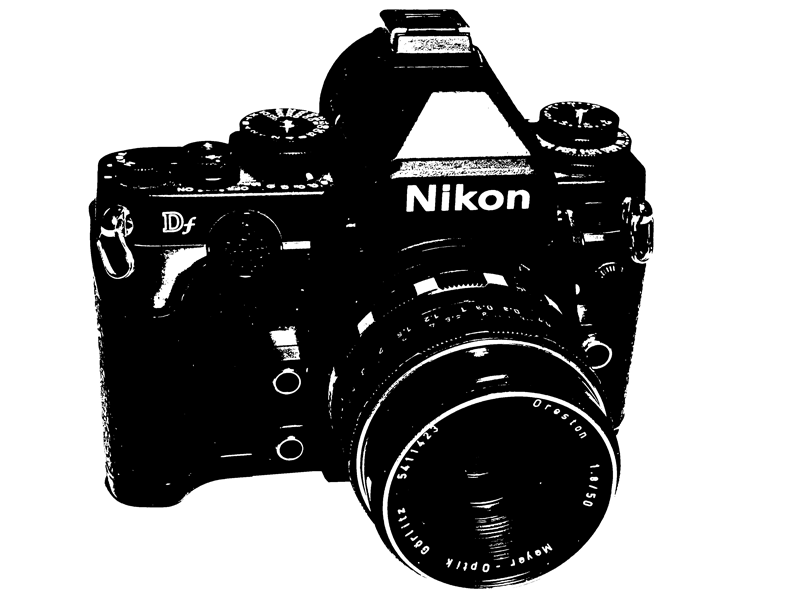I recently1 visited a vintage/legacy camera fair in Helsinki.
Among a lot of lenses I already have and a lot of gear I cannot afford, I ended up chatting with a young man who – it turned out – is an occasional reader of JAPB. After some nice words about how JAPB has helped him understand more about legacy gear, he popped the question: “What is it you and other bloggers always write about some combinations of legacy lenses and digital cameras, that the combination does not allow infinity focus … Is this not a rather fringe issue?”
And to address the first part of his comment, I indeed often warn about this. Take for instance: This passage from the data sheet of the Meyer-Optik Görlitz Orestor 100 mm f/2.8 (one of my all-time favourite lenses):

Regarding the second issue (whether a lack of infinity focus is a fringe issue), after some more dialogue it turned out that that young man took the “no infinity focus” quite literally (as an indication that only actual infinity focus is unattainable).
And indeed, while I am a rather pedantic individual, even I might have used some phrase that could help propagate this misunderstanding (I usually try to indicate that the problem may be more pervasive than limited to just infinity focus, as in the example above) but I know that a lot of bloggers (never mind experts on social media) are not as careful in how they express themselves.
The obvious follow-up question then is: So how much more than infinity focus do you lose? Can you still focus across the room? And there the answer is not simple because there are too many factors, but in general:
• The bigger the negative flange focal distance is, the more of the lens’ designed focusing range you lose.
• The shorter the focal length, the more of the lens’ designed focusing range you lose. This is further complicated by that the lens’ design can affect the result unexpectedly.
Maybe an illustration through some examples can help :
Case: M42 lenses (flange focal distance 45,46 mm) and a Nikon F camera (flange focal distance 46,5 mm) mated through a very thin (0,87 mm) adapter ring.
The difference between the designed flange focal distance (45,46 mm) and the actual flange focal distance (46,5 mm + 0,87 mm= ) is -1,91 mm. This number assumes a perfect fit between lens and adapter and adapter and body, which is unlikely, so we can safely round up the negative flange focal distance to 2 mm.
We can next mount a series of M42 lenses on this combination of body and adapter, set the lens to infinity2, and measure the distance at which the lens is in focus. Below are the results on a lens-by-lens basis
Pentacon auto 200 mm f/4 MC
Observed focusing distance with lens set to Infinity: ≈14,3 meters
Lost focusing ability: 14,3 meters to infinity
Pentacon auto 135 mm f/2.8 MC
Observed focusing distance with lens set to Infinity: ≈8,4 meters
Lost focusing ability: 8,4 meters to infinity
Meyer-Optik Görlitz Orestor 100 mm f/2.8
Observed focusing distance with lens set to Infinity: ≈6,1 meters
Lost focusing ability: 6,1 meters to infinity
Helios 44-2 58 mm f/2
Observed focusing distance with lens set to Infinity: 2,45 meters
Lost focusing ability: 2,45 meters to infinity
Meyer-Optik Oreston 50 mm f/1.8
Observed focusing distance with lens set to Infinity: ≈1,7 meters
Lost focusing ability: 1,7 meters to infinity
Chinon (Auto Chinon) 35 mm f/2.8
Observed focusing distance with lens set to Infinity: ≈1,1 meters
Lost focusing ability: 1,1 meters to infinity
Pentacon auto 29 mm f/2.8
Observed focusing distance with lens set to Infinity: 52 centimeters
Lost focusing ability: ≈0,5 meters to infinity
Vivitar (Kiron) 24 mm f/2
Observed focusing distance with lens set to Infinity: 49 centimeters
Lost focusing ability: ≈0,5 meters to infinity
Carl Zeiss Jena Flektogon 20 mm f/4
Observed focusing distance with lens set to Infinity: 32 centimeters
Lost focusing ability: ≈0,3 meters to infinity
Side note: “Those numbers make no sense …”
I understand your reaction, because they do indeed seem a bit inconsistent (the correlation between the amount of shift of infinity and focal length is not really linear), but I remind you of a bit I wrote earlier: ” shorter the focal length, the more of the lens’ designed focusing range you lose. This is further complicated by that the lens’ design can affect the result unexpectedly.“( emphasis added)
What this actually means is that while the shift in flange focal distance might be constant in comparison to the flange focal distance of the lens, it is not constant in comparison with the distance between the lens’ exit pupil and the sensor. Because lenses with the same specifications can use very different optical designs, so too the distance between exit pupil and imaging plane is not the same with all lenses of a similar focal length/angle-of-view.
To emphasis the point, I grabbed a few other 50 mm M42 lenses that I had lying around, and while the first two offered numbers that were not too distant3 from those of the MOR Oreston I first tested, I hit pay-dirt with the third lens I grabbed: The A.Schacht Ulm Praktica-S-Travelon 1:1,8/50 R’s infinity had shrunk to 1,11 meters (very close to the numbers from the 35 mm Chinon).
Where does this leave us?
It depends on the combination of body and lens (and how big the ensuing negative flange focal length difference is), on the lens (and its design) and whether you expect the lens to be your one-trick pony or whether you want the lens to retain its designed versatility.
Certainly you might take a lens like the MOG Orestor 100/2.8, plug it on your Nikon F dSLR and decide you’ll just use it for portraiture. Depending on what you want to do with the lens, you might even decide that you can live with not being able to focus past 2,5 (Helios) or even 1,7 (Oreston) meters.
But with the wide-angle lenses, these limitations quickly become prohibitive. Hence, it is very tangibly not only infinity which you lose, you lose a lot of the lens’ versatility You make every thoroughbred into a one-trick-pony.
It is a bit like a lens that has a jammed extension ring always following it around, with one added limitation…
Did you say extension ring? Does this not make the lens perfect for macro?
Sadly, not really. Because while the ≈ 2 mm ‘extension ring’ is enough to ruin your ability to focus on distant subjects, 2 mm is far from enough to give you close focusing capabilities worth mentioning.
To take a few examplse:
• The native MFD of the 200 mm Pentacon is 2,7 meters. With the involuntary extension ring attached, that improves marginally to ≈2,5 meters.
• The 50 mm Oreston has an impressive MFD of 33 centimetres even without an involuntary boost. Sadly, that boost only improves the close focusing ability by a few centimetres (to 30 centimetres).
Therefore, there really is no upside that would even start compensating for the downsides.
Personally, I have long since stopped dabbling with any combinations that can lead to a loss of infinity focus. That said, I’d love to hear your views on the matter.
Footnotes
- Well … Actually it was in the beginning of November 2024, but I only now have a chance to write down my thoughts. ↩︎
- Please note that this does not pretend to be a scientific optical measurement as there are too many factors involved that lead or can lead to loss of precision. Hence, these numbers are intended first and foremost as an illustration. ↩︎
- (meaning: within +/- 10%) ↩︎
